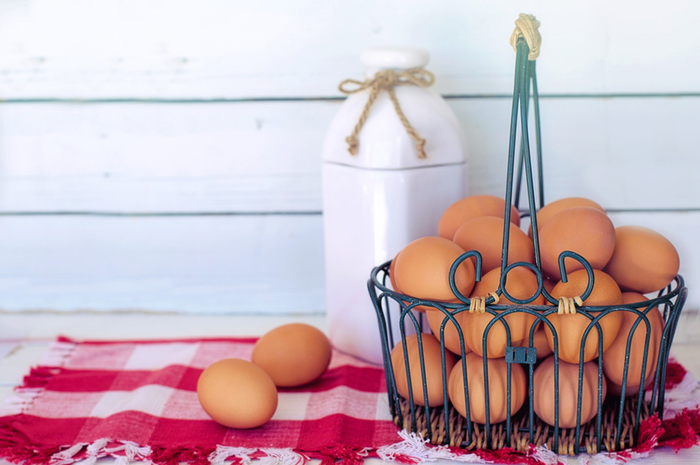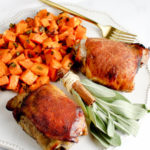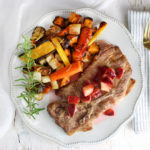
What can you eat for breakfast on the Autoimmune Protocol? This is a question I get asked often and I understand the struggle!
Once you eliminate all grains, processed foods, nuts, seeds, eggs, as well as coffee and chocolate, there is now a huge void at the beginning of the day. No more quick and easy options such as bread, muffins, bagels, doughnuts, cereals, or even omelets! (Learn more about the Autoimmune Protocol here).
I have been through this process myself and I would like to give you my top 10 tips to eat a fabulous AIP breakfast that will fuel your body for the day.

Before I begin, take a closer look at the picture above. All the meals are representative of my breakfasts on the Autoimmune Protocol. If you follow me on Instagram, you might recognize a few pictures!
As you can see, my breakfasts look a lot like my dinners! Once you break away from the mold of the Standard American Diet, you will discover that there are so many healthy options possible.
If you think that this is too hard for you, remember that it is difficult only until it becomes a new habit. And it usually takes about 21 days to form a new habit! Think you can do this?
9 tips for a great AIP breakfast!
1. Do not skip breakfast! Especially if you suffer from an autoimmune disorder, it is very important to eat regularly throughout the day so that your blood sugar level won’t get too low. Low blood sugar level will actually promote autoimmune flare-ups and may aggravate your condition. Some symptoms of low blood sugar are mood changes, nervousness, fatigue, headaches, and trouble concentrating.
2. Keep sweet breakfasts to a minimum. An AIP treat is still a treat! While we all need a little something sweet from time to time, don’t make a habit to eat AIP pancakes or AIP waffles for breakfast. Keep those for a Sunday brunch or special occasions. Eating a sugary breakfast will create an insulin spike, which will increase the inflammation in your body and trigger autoimmune flares. You will know you have an insulin surge if you feel tired after eating or drinking something sugary, or if you crave even more sugar.
3. Choose a savory breakfast with proteins, lots of vegetables, and healthy fats. The best way to fuel your body for the day ahead of you is by eating a breakfast that will provide you with all the nutrients your body needs to produce sustained energy. Ideally, your breakfast should be made of:
• Proteins = meat, poultry, and seafood
• Vegetables = I like to have at least 1 low starch vegetable (low-starch vegetables are typically flowering parts of the plant like lettuce, asparagus, broccoli, cauliflower, cucumber, spinach, mushrooms, onions, zucchini, yellow squash, leeks) and 1 high starch vegetable (high starch vegetables are typically root vegetables like sweet potatoes, beets, and all winter squashes).
I do well with a moderate amount of starchy vegetables, but it might not be the case for you. Listen to your body as we are all different.
• Healthy fats = avocado, avocado oil, olive oil, coconut oil, bacon fat, lard, tallow, duck fat. Eating enough fat will keep you satiated longer, preventing the snacking – grazing in between meals.
• Fruits = all fruits are allowed on the autoimmune protocol (with the exception of goji berries which are nightshades). However, it is advised to limit fruit consumption to one or two servings per day because of their fructose content. Berries are the best choice when in season!
4. Chop your vegetables in advance. On grocery shopping days, as soon as I get back home, I start cleaning, cutting, and chopping my vegetables. I keep them stored in big Ziploc bags, in the lower compartments in my refrigerator. This way, I don’t have to start cleaning my vegetables in the morning when I wish to prepare a skillet of some sort. I simply grab a few handfuls of different vegetables and pair them with some protein. I explain the process in details (with pictures) in this post.

5. Leftovers are the best! Often I prepare more food than I can eat for dinner at night and I eat the leftovers for breakfast the next day. They are easy to warm-up quickly, and you can add some fresh vegetables on the side (like a store bought lettuce mix). Pro tip: when cooking large amounts of vegetables to be used as leftovers later, I slightly undercook them so that they don’t turn mushy when reheated.
6. Batch cooking will save you a lot of time! The best way to stay on track with your AIP diet is to be prepared at all time, especially for breakfast. A good way to always have food ready is to batch cook. Batch cooking means that you spend one or two longer sessions in the kitchen preparing a big load of food that you can warm-up the following days. Typical batch cook preparations include burgers, patties, bone broth, soups, skillet fixings, and roasted vegetables.
7. Use your slow cooker during the night. I love to wake up in the morning to the mouthwatering smells of a homemade slow-cooked meal! Even better than the delicious aromas, you don’t have to prepare anything; all you have to do is fill up your plate and dig in. Any recipe for a crockpot meal will work for breakfast. Check out this spring breakfast chicken soup to get started!
8. Bone broth to the rescue! If you are a little bit under the weather or don’t feel like eating a full meal for breakfast, try some nutrient-dense, gut-healing bone broth. Bone broth is a rich source of minerals as well as gut healing collagen. In any case, it is always a good idea to add a warm cup of bone broth to your breakfast routine. It is an excellent replacement if you are trying to break the habit of drinking coffee!
9. Breakfast shakes. Some of us prefer to drink a shake for breakfast. That is perfectly fine! Make sure you add a good serving of vegetables, a serving of healthy fat (such as half an avocado), and a source of protein to your shake. A popular AIP-approved protein powder you can use in your shakes and smoothies is collagen powder. Add 1 or 2 TBSP to your shake and mix well. Try this delicious strawberry-mango breakfast shake or this Immune Boosting Green Detox Smoothie!
I hope you find this post helpful! As you can see, the key to being successful on the AIP diet is to change your mindset and be prepared. Don’t focus on what you can not eat anymore, but instead be resourceful and find new strategies to feed yourself in a way that will promote your healing.








Great site!
I love your website! Very helpful and informative!
just starting my journey. thanks for the tips.
please add to mailing list
Where is the breakfast recipes for the picture on top of this page? its now here to be found
What does the picture show for you?
Hi Sophie, Love your site! Also a CO gal here. We are dealing with a few health issues in our home. My 18 yo daughter is dealing with Lyme from an Oregon hiking trip. I am dealing with some gut issues that started with a virus but became all out war on my body when the traditional docs plied me with antibiotics, steroids, and PPis. To put the cherry on the top, we have been exposed to mold, Yikes! Thyroid problems, gut problems, and fibromyalgia are all residents in our house. We were starting to make headway on AIP, then the holidays hit and we are still struggling to get back on the rails. Being totally prepared is the only way I can do this. Brain fog stinks. Breakfast is a huge part of our day with all the pills we need to take. I have your picture above printed out and I reference it often. The only thing is, I really wish I could tell what everything is on the plates. Is there any way you could give us a cheat sheet of the items on each plate? We really could use the variety around here. Thank you!!
Hello Leslie,
I am sorry but I don’t have a cheat sheet for all the plates in the picture. The best way to know what’s on my plate is to follow me on Instagram! If you go back in time and look at the pictures, you will also have a description in the comments. I hope this helps 🙂
I would love more info on this diet! I have Hashimoto’s Thyroid disease!
Thank you for the info. Hypothyroid is my issue. (thinning hair and weight gain)
Tried other programs without much success.
I am SO glad I found this site ! I have been struggling with AIP for weeks now.
Thank you for your amazing tips
Thank you for your website, Sophie! I’ve been struggling with Grave’s/Hyperthyroidism for years and just now realizing I need to change my diet to the AIP diet. I’m looking forward to using the tips on your website!
Hello Lynn and welcome aboard! – Sophie
Great site and info!! Thank you so much. Only thing it might be nice to store your cut up veggies in glass mason jars or reusable glass containers. All that plastic waste in pics each week makes me a bit sad.
Is the AIP Breakfast meals book available in print?
No, only ebook.